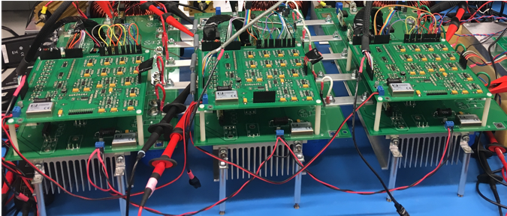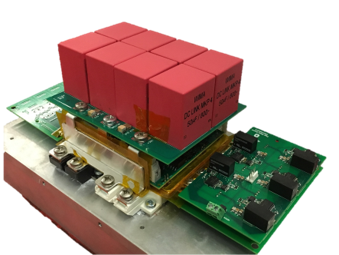Innovation
In response to the growing aviation demands and the concern of environment and energy usage, hybrid/turbo-electric propulsion systems have been proposed by NASA. In this new concept, high power-density (specific power) and high-efficiency electric machines and power conditioning equipment (power electronics converters), and energy storage devices are the critical components that determine the success of this future aero- transportation architecture. NASA’s technical specifications for this future hybrid/turbo-electric propulsion system include 15 kW/kg power density and 99.5% efficiency for electric machines, 25 kW/kg power density and 99.5% efficiency for power electronics converters.
Background
This project completed the design, manufacturing, and testing of the 300-kW electric machine and power converter systems. The measured efficiency for the 300-kW power converter is 98.9% under rated DC voltage (1 kV) and rated current (280 A). The power density of the power converter achieved 22 kW/kg based on the actual masses of power converter components. The cold plate is included in the power density calculation. The EMI filter is not included in the power density calculation. The measured efficiency of the 300-kW machine and drive system is shown in section 3.4. Over a large operation area, the machine and drive system can achieve an efficiency of 99%. The power density of the 300-kW machine prototype is 13.6 kW/kg based on counting the masses for all active materials including iron, copper, magnets, and sleeve. The shaft, cooling system, and housing of the machine are not included.
The project attracted two aviation industry companies as future collaborators, i.e., Boeing and Safran. Both joined the Center for High Performance Power Electronics (CHPPE) Consortium. Safran partners with Ohio State University to develop brushless doubly fed machines for aircraft propulsion, which is the ongoing OFRN Round 3 SOARING program. Boeing has an ongoing project with CHPPE to study 3-stage electric generator system for aircraft. Boeing is regularly following up on the SOARING program and is interested in using the brushless doubly-fed machines to replace the 3-stage electric generator system.
Commercial Goal
This project generated 22 new jobs including 4 new PhD students who are directly on the project and led to the NASA University Leadership Initiative (ULI) Program at Ohio State University that created another 18 new positions. This project also generated a total of $17,095 K follow-on research funding and federal government and industry. The details are shown in Section 5.2.
OFRN helped create many collaboration opportunities between Ohio State University and federal government funding agencies and private companies such as NASA, DoE, Boeing and Safran. University researchers from OSU and Akron had close collaboration to understand the electric drive system fault diagnosis as well. The major lesson learnt from this project is that Ohio State University needs a reliable collaborator on the mechanical design and manufacturing of high-power-density high-efficiency electric machines. Both Safran and the Center for Design and Manufacturing Excellence (CDME) at Ohio State University have become close collaborators with the project team to solve all challenging mechanical design issues for electric machines for multiple ongoing project.



